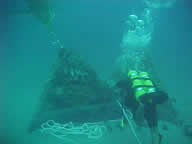Project Description |
| FISH
WATCH is a project studying marine fish behavior,
movements, and species groupings in continental shelf waters off the
coast of the state of Georgia. Collaborating in this study are the
South Carolina Department of Natural Resources, Marine Resources Division,
the Skidaway Institute of Oceanography, and the US Naval TACTS program.
The study is funded in part by the Office of Naval Research, National
Ocean Partnership Program. The study is conducted with an observational
system of 6 underwater cameras that monitor the activities around
an artificial reef habitat. The artificial reef consists of concrete
pyramids that were deployed in the spring of 1999. Since then, extensive
invertebrate
 growth has occurred on these pyramids. These artificial reefs attract
fish typically found in reef habitats, and the cameras monitor their
activity. The video gathered is in the form of 10 second clips. The
clips are in black and white and the quality is limited by the factors
present on site, including water turbidity, fish activity, time of
day, and surface conditions.
growth has occurred on these pyramids. These artificial reefs attract
fish typically found in reef habitats, and the cameras monitor their
activity. The video gathered is in the form of 10 second clips. The
clips are in black and white and the quality is limited by the factors
present on site, including water turbidity, fish activity, time of
day, and surface conditions.The FISH
WATCH project has both educational and research objectives.
The main goal of this education section is to make the research information
that is being collected available to students, teachers, and the general
public in a clear, and interesting format and accompany the video
clips with information regarding the species and their behaviors.
Using the video archive as a resource, teachers and other educators
can create activities and lessons for students to learn more about
assemblages of fish that inhabit regional reef ecosystems of the South
Atlantic Bight continental shelf. |

